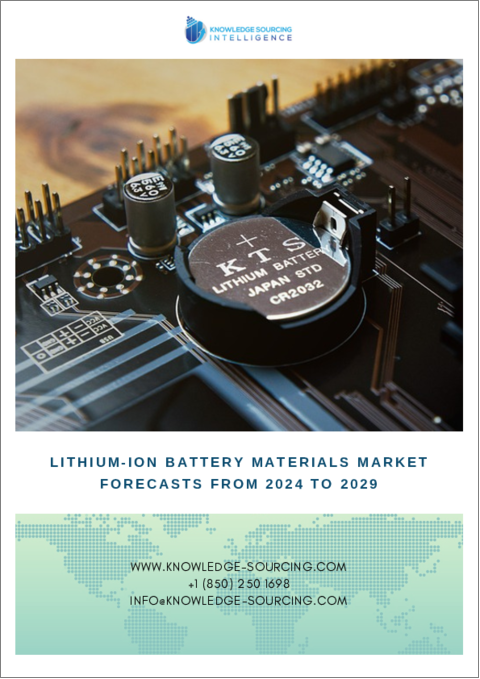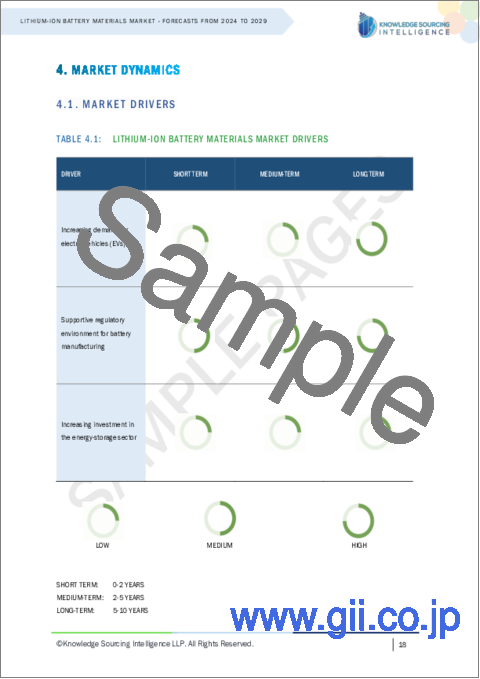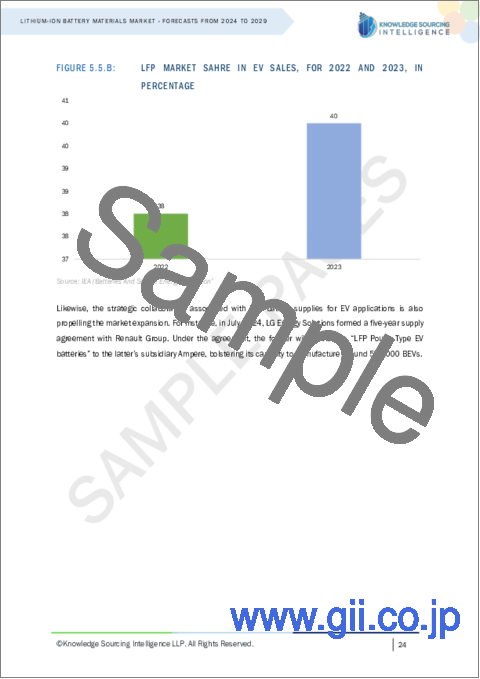|
|
市場調査レポート
商品コード
1457031
リチウムイオン電池材料市場-2024年から2029年までの予測Lithium-Ion Battery Materials Market - Forecasts from 2024 to 2029 |
||||||
カスタマイズ可能
|
|||||||
| リチウムイオン電池材料市場-2024年から2029年までの予測 |
|
出版日: 2024年02月16日
発行: Knowledge Sourcing Intelligence
ページ情報: 英文 142 Pages
納期: 即日から翌営業日
|
全表示
- 概要
- 目次
リチウムイオン電池材料市場はCAGR15.41%で上昇し、2022年の342億米ドルから2029年には932億7,300万米ドルの市場規模に達すると予測されます。
リチウムイオン電池材料市場は、技術革新、経済的考察、環境的要請を含む多くの要因の影響を受けています。新しい材料と化学に焦点を当てた研究開発の継続的な努力により、エネルギー密度を高めた電池が生まれ、電気自動車の航続距離延長や電子機器の使用時間延長を可能にしています。さらに、製造技術と材料抽出プロセスの継続的な進歩により、リチウムイオン電池の総コストが低下し、さまざまな用途で利用しやすくなっています。
iea.orgのデータによると、太陽光発電容量は2022年に1,177.4GWに達し、2026年には2,835.5GWに達すると予測されています。このことは、太陽光発電や風力発電のような再生可能エネルギー源をグリッドにシームレスに統合するために、効果的なエネルギー貯蔵ソリューションの必要性が高まっていることを強調しています。その結果、グリッドストレージ用途におけるリチウムイオン電池の需要が大幅に増加しています。
電気自動車(EV)の需要増が市場を後押し。
大型のリチウムイオン電池に大きく依存していることから、電気自動車の需要増加が極めて重要な推進力となっています。電気自動車の導入を促進することを目的とした政府のインセンティブと規制措置は、市場の成長をさらに増大させる。特に、世界の電気自動車販売台数の急増は、2020年の297万台から2022年には1,020万台に拡大し、電気自動車の世界の急速な普及を裏付けています。さらに、新しい消費者向けガジェットの需要が急増しており、電池の生産が促進されると予想されます。スマートフォンのような民生用電子機器では、使いやすさを長持ちさせるために電池容量の強化が必要です。さらに、可処分所得が増加するにつれて、民生用電子機器に対する欲求は急増すると予想され、それによって予測期間中の電池材料市場の成長が促進されます。
市場は北米地域で成長すると予測されています。
リチウムイオン電池材料市場は、その後の成長率で上昇すると予測されます。この業界は、環境規制や政府規制の変化による影響を受けると予想され、市場成長にも課題が予想されます。さらに、製品の発売、提携、合意、買収、その他の関連要因を含む発展が増加しています。また、市場は特定の産業に依存することが予想されます。リチウムイオン電池材料市場の成長は、主にいくつかの重要な要因によってもたらされます。まず、EVやポータブル電子機器の需要の増加が、高度な電池技術の必要性を煽っています。さらに、気候変動を緩和するための再生可能エネルギー貯蔵ソリューションの推進も市場拡大に寄与しています。エネルギー密度の向上、電池寿命の延長、安全性の向上につながる技術の進歩は、成長をさらに後押しします。クリーンな輸送とエネルギー貯蔵を促進する政府の奨励策や規制も大きな役割を果たしています。さらに、電池生産コストの低下と充電ステーション用インフラの拡大が、市場の取り込みを後押ししています。
主要参入企業
- 世界有数の化学会社であるBASF SEは、リチウムイオン電池材料市場で極めて重要な役割を果たしています。BASFは、材料科学の専門知識を活かして、リチウムイオン電池の革新的なソリューションを開発し、その性能、耐久性、安全性を高めています。BASFは持続可能性に重点を置き、環境に優しい電池材料の開発に取り組んでおり、EVやエネルギー貯蔵システムの需要拡大に対応しています。
- 革新的な製品の多様なポートフォリオで有名な3Mは、リチウムイオン電池材料市場の主要参入企業です。同社の先端材料部門は、セパレーターや電極など、リチウムイオン電池用の高性能部品の開発に特化しています。3Mの絶え間ない研究開発の追求により、電池の効率、寿命、安全性を高める最先端の材料が生み出されています。
- Tanaka Chemical Corporationは、リチウムイオン電池材料市場において著名な参入企業であり、電池製造に不可欠な特殊化学品や材料の生産に優れています。田中化成の専門性は、正極と負極の配合に不可欠なリチウム、コバルト、ニッケルなどの高純度金属の開発にあります。品質と信頼性にこだわり、その材料が厳しい業界基準を満たすことを保証し、高性能なリチウムイオン電池の製造を可能にしています。Tanaka Chemical Corporationの電池材料市場への貢献は、電気自動車や再生可能エネルギーソリューションの普及を促進し、より持続可能な未来への移行を推進する上で重要な役割を担っています。
目次
第1章 イントロダクション
- 市場概要
- 市場の定義
- 調査範囲
- 市場セグメンテーション
- 通貨
- 前提条件
- 基準年と予測年のタイムライン
- 利害関係者にとっての主要メリット
第2章 調査手法
- 調査デザイン
- 調査プロセス
第3章 エグゼクティブサマリー
- 主要調査結果
- アナリストビュー
第4章 市場力学
- 市場促進要因
- 市場抑制要因
- ポーターのファイブフォース分析
- 業界バリューチェーン分析
- アナリストビュー
第5章 リチウムイオン電池材料市場:電池化学分析別
- イントロダクション
- LMO
- 市場動向と機会
- 成長の展望
- 地理的収益性と洞察
- NCA
- 市場動向と機会
- 成長の展望
- 地理的収益性と洞察
- LCO
- 市場動向と機会
- 成長の展望
- 地理的収益性と洞察
- LFP
- 市場動向と機会
- 成長の展望
- 地理的収益性と洞察
- NMC
- 市場動向と機会
- 成長の展望
- 地理的収益性と洞察
第6章 リチウムイオン電池材料市場:材料別
- イントロダクション
- 陽極
- 陰極
- 電解質
第7章 リチウムイオン電池材料市場:用途別
- イントロダクション
- 電気自動車
- 産業
- ポータブルデバイス
第8章 リチウムイオン電池材料市場:地域別
- イントロダクション
- 北米
- 南米
- 欧州
- 中東・アフリカ
- アジア太平洋
第9章 競合環境と分析
- 主要企業と戦略分析
- 市場シェア分析
- 合併、買収、合意とコラボレーション
- 競合ダッシュボード
第10章 企業プロファイル
- BASF SE
- 3M
- Tanaka Chemical Corporation
- Sumitomo Metal Mining Co., Ltd.
- Resonac Holdings Corporation
- Umicore
- SGL Carbon
- UBE Corporation
- NEI Corporation
The Lithium-Ion battery materials market is projected to rise at a compound annual growth rate (CAGR) of 15.41% to reach a market valuation of US$93.273 billion by 2029, from US$34.200 billion in 2022.
The Lithium-Ion Battery Material Market is influenced by many factors, encompassing technological innovations, economic considerations, and environmental imperatives. Ongoing research and development endeavours focused on novel materials and chemistry are resulting in batteries with heightened energy density, enabling extended ranges for electric vehicles and prolonged usage times for electronic gadgets. Furthermore, continuous progress in manufacturing techniques and material extraction processes is driving down the overall cost of lithium-ion batteries, rendering them more accessible across diverse applications.
As per data from iea.org, the capacity of Solar PV electricity stood at 1177.4GW in 2022, projected to reach 2835.5GW by 2026. This underscores the growing need for effective energy storage solutions to seamlessly integrate renewable energy sources like solar and wind power into the grid. Consequently, the demand for lithium-ion batteries in grid storage applications is experiencing a significant boost.
Increasing demand for electric vehicles (EVs) propels the market.
The increasing demand for electric vehicles emerges as a pivotal driver, given their substantial reliance on large lithium-ion batteries. Government incentives and regulatory measures aimed at promoting the adoption of electric vehicles further augment market growth. Notably, the surge in global electric vehicle sales, which escalated from 2.97 million cars in 2020 to 10.2 million in 2022, underscores the rapid adoption of electric vehicles worldwide, consequently propelling the demand for lithium-ion batteries prominently utilized in electric cars. Additionally, the burgeoning demand for new consumer gadgets is expected to drive battery production. Consumer electronics, like smartphones, necessitate enhanced battery capacity to prolong their usability. Moreover, as disposable income rises, the appetite for consumer electronics is expected to surge, thereby propelling growth in the battery materials market over the projected time period.
The market is projected to grow in the North American region.
The lithium-ion battery materials market is projected to rise at a subsequent growth rate. The industry is expected to be affected by changing environmental and governmental regulations, which are anticipated to challenge market growth as well. In addition, the increasing advancements and market developments, including product launches, collaborations, agreements, acquisitions, and other related factors. The market is also expected to be dependent on certain industries. The lithium-ion battery materials market growth is primarily driven by several key factors. Firstly, the increasing demand for EVs and portable electronics fuels the need for advanced battery technologies. Additionally, the push towards renewable energy storage solutions to mitigate climate change contributes to market expansion. Technological advancements leading to higher energy density, longer battery life, and improved safety further propel growth. Government incentives and regulations promoting clean transportation and energy storage also play a significant role. Moreover, the declining costs of battery production and the expanding infrastructure for charging stations bolster market uptake.
Key Players:
- BASF SE, a leading global chemical company, plays a pivotal role in the lithium-ion battery materials market. Leveraging its expertise in material science, BASF develops innovative solutions for lithium-ion batteries, enhancing their performance, durability, and safety. With a focus on sustainability, BASF is committed to developing eco-friendly battery materials, meeting the growing demand for EVs and energy storage systems. Its comprehensive portfolio includes cathode materials, electrolytes, and additives, catering to diverse applications across automotive, electronics, and renewable energy sectors.
- 3M, renowned for its diversified portfolio of innovative products, is a key player in the lithium-ion battery materials market. The company's advanced materials division specializes in developing high-performance components for lithium-ion batteries, such as separators and electrodes. 3M's relentless pursuit of research and development enables the creation of cutting-edge materials that enhance battery efficiency, longevity, and safety. With a global presence and a strong focus on technological advancements, 3M continues to drive innovation in the lithium-ion battery materials industry, addressing the evolving needs of electric mobility and energy storage markets.
- Tanaka Chemical Corporation, a prominent player in the lithium-ion battery materials market, excels in the production of specialty chemicals and materials essential for battery manufacturing. Tanaka Chemical's expertise lies in the development of high-purity metals, including lithium, cobalt, and nickel, crucial for cathode and anode formulations. With a commitment to quality and reliability, the company ensures that its materials meet stringent industry standards, enabling the production of high-performance lithium-ion batteries. Tanaka Chemical Corporation's contributions to the battery materials market are instrumental in facilitating the widespread adoption of electric vehicles and renewable energy solutions, driving the transition towards a more sustainable future.
Segmentation:
By Battery Chemistry:
- LMO
- NCA
- LCO
- LFP
- NMC
By Material:
- Anode
- Cathode
- Electrolyte
By Application:
- Electric Vehicle
- Industrial
- Portable Device
By Geography
- North America
- United States
- Canada
- Mexico
- South America
- Brazil
- Argentina
- Others
- Europe
- United Kingdom
- Germany
- France
- Italy
- Spain
- Others
- Middle East and Africa
- Saudi Arabia
- UAE
- Others
- Asia Pacific
- Japan
- China
- India
- South Korea
- Taiwan
- Thailand
- Indonesia
- Others
TABLE OF CONTENTS
1. INTRODUCTION
- 1.1. Market Overview
- 1.2. Market Definition
- 1.3. Scope of the Study
- 1.4. Market Segmentation
- 1.5. Currency
- 1.6. Assumptions
- 1.7. Base, and Forecast Years Timeline
- 1.8. Key benefits for the stakeholders
2. RESEARCH METHODOLOGY
- 2.1. Research Design
- 2.2. Research Process
3. EXECUTIVE SUMMARY
- 3.1. Key Findings
- 3.2. Analyst View
4. MARKET DYNAMICS
- 4.1. Market Drivers
- 4.2. Market Restraints
- 4.3. Porter's Five Forces Analysis
- 4.3.1. Bargaining Power of Suppliers
- 4.3.2. Bargaining Power of Buyers
- 4.3.3. Threat of New Entrants
- 4.3.4. Threat of Substitutes
- 4.3.5. Competitive Rivalry in the Industry
- 4.4. Industry Value Chain Analysis
- 4.5. Analyst View
5. LITHIUM-ION BATTERY MATERIALS MARKET BY BATTERY CHEMISTRY
- 5.1. Introduction
- 5.2. LMO
- 5.2.1. Market Trends and Opportunities
- 5.2.2. Growth Prospects
- 5.2.3. Geographic Lucrativeness and Insights
- 5.3. NCA
- 5.3.1. Market Trends and Opportunities
- 5.3.2. Growth Prospects
- 5.3.3. Geographic Lucrativeness and Insights
- 5.4. LCO
- 5.4.1. Market Trends and Opportunities
- 5.4.2. Growth Prospects
- 5.4.3. Geographic Lucrativeness and Insights
- 5.5. LFP
- 5.5.1. Market Trends and Opportunities
- 5.5.2. Growth Prospects
- 5.5.3. Geographic Lucrativeness and Insights
- 5.6. NMC
- 5.6.1. Market Trends and Opportunities
- 5.6.2. Growth Prospects
- 5.6.3. Geographic Lucrativeness and Insights
6. LITHIUM-ION BATTERY MATERIALS MARKET BY MATERIAL
- 6.1. Introduction
- 6.2. Anode
- 6.2.1. Market Trends and Opportunities
- 6.2.2. Growth Prospects
- 6.2.3. Geographic Lucrativeness
- 6.3. Cathode
- 6.3.1. Market Trends and Opportunities
- 6.3.2. Growth Prospects
- 6.3.3. Geographic Lucrativeness
- 6.4. Electrolyte
- 6.4.1. Market Trends and Opportunities
- 6.4.2. Growth Prospects
- 6.4.3. Geographic Lucrativeness
7. LITHIUM-ION BATTERY MATERIALS MARKET BY APPLICATION
- 7.1. Introduction
- 7.2. Electric Vehicle
- 7.2.1. Market Trends and Opportunities
- 7.2.2. Growth Prospects
- 7.2.3. Geographic Lucrativeness
- 7.3. Industrial
- 7.3.1. Market Trends and Opportunities
- 7.3.2. Growth Prospects
- 7.3.3. Geographic Lucrativeness
- 7.4. Portable Device
- 7.4.1. Market Trends and Opportunities
- 7.4.2. Growth Prospects
- 7.4.3. Geographic Lucrativeness
8. LITHIUM-ION BATTERY MATERIALS MARKET BY GEOGRAPHY
- 8.1. Introduction
- 8.2. North America
- 8.2.1. By Battery Chemistry
- 8.2.2. By Material
- 8.2.3. By Application
- 8.2.4. By Country
- 8.2.4.1. United States
- 8.2.4.1.1. Market Trends and Opportunities
- 8.2.4.1.2. Growth Prospects
- 8.2.4.2. Canada
- 8.2.4.2.1. Market Trends and Opportunities
- 8.2.4.2.2. Growth Prospects
- 8.2.4.3. Mexico
- 8.2.4.3.1. Market Trends and Opportunities
- 8.2.4.3.2. Growth Prospects
- 8.2.4.1. United States
- 8.3. South America
- 8.3.1. By Battery Chemistry
- 8.3.2. By Material
- 8.3.3. By Application
- 8.3.4. By Country
- 8.3.4.1. Brazil
- 8.3.4.1.1. Market Trends and Opportunities
- 8.3.4.1.2. Growth Prospects
- 8.3.4.2. Argentina
- 8.3.4.2.1. Market Trends and Opportunities
- 8.3.4.2.2. Growth Prospects
- 8.3.4.3. Others
- 8.3.4.3.1. Market Trends and Opportunities
- 8.3.4.3.2. Growth Prospects
- 8.3.4.1. Brazil
- 8.4. Europe
- 8.4.1. By Battery Chemistry
- 8.4.2. By Material
- 8.4.3. By Application
- 8.4.4. By Country
- 8.4.4.1. United Kingdom
- 8.4.4.1.1. Market Trends and Opportunities
- 8.4.4.1.2. Growth Prospects
- 8.4.4.2. Germany
- 8.4.4.2.1. Market Trends and Opportunities
- 8.4.4.2.2. Growth Prospects
- 8.4.4.3. France
- 8.4.4.3.1. Market Trends and Opportunities
- 8.4.4.3.2. Growth Prospects
- 8.4.4.4. Italy
- 8.4.4.4.1. Market Trends and Opportunities
- 8.4.4.4.2. Growth Prospects
- 8.4.4.5. Spain
- 8.4.4.5.1. Market Trends and Opportunities
- 8.4.4.5.2. Growth Prospects
- 8.4.4.6. Others
- 8.4.4.6.1. Market Trends and Opportunities
- 8.4.4.6.2. Growth Prospects
- 8.4.4.1. United Kingdom
- 8.5. Middle East and Africa
- 8.5.1. By Battery Chemistry
- 8.5.2. By Material
- 8.5.3. By Application
- 8.5.4. By Country
- 8.5.4.1. Saudi Arabia
- 8.5.4.1.1. Market Trends and Opportunities
- 8.5.4.1.2. Growth Prospects
- 8.5.4.2. UAE
- 8.5.4.2.1. Market Trends and Opportunities
- 8.5.4.2.2. Growth Prospects
- 8.5.4.3. Others
- 8.5.4.3.1. Market Trends and Opportunities
- 8.5.4.3.2. Growth Prospects
- 8.5.4.1. Saudi Arabia
- 8.6. Asia Pacific
- 8.6.1. By Battery Chemistry
- 8.6.2. By Material
- 8.6.3. By Application
- 8.6.4. By Country
- 8.6.4.1. Japan
- 8.6.4.1.1. Market Trends and Opportunities
- 8.6.4.1.2. Growth Prospects
- 8.6.4.2. China
- 8.6.4.2.1. Market Trends and Opportunities
- 8.6.4.2.2. Growth Prospects
- 8.6.4.3. India
- 8.6.4.3.1. Market Trends and Opportunities
- 8.6.4.3.2. Growth Prospects
- 8.6.4.4. South Korea
- 8.6.4.4.1. Market Trends and Opportunities
- 8.6.4.4.2. Growth Prospects
- 8.6.4.5. Taiwan
- 8.6.4.5.1. Market Trends and Opportunities
- 8.6.4.5.2. Growth Prospects
- 8.6.4.6. Thailand
- 8.6.4.6.1. Market Trends and Opportunities
- 8.6.4.6.2. Growth Prospects
- 8.6.4.7. Indonesia
- 8.6.4.7.1. Market Trends and Opportunities
- 8.6.4.7.2. Growth Prospects
- 8.6.4.8. Others
- 8.6.4.8.1. Market Trends and Opportunities
- 8.6.4.8.2. Growth Prospects
- 8.6.4.1. Japan
9. COMPETITIVE ENVIRONMENT AND ANALYSIS
- 9.1. Major Players and Strategy Analysis
- 9.2. Market Share Analysis
- 9.3. Mergers, Acquisitions, Agreements, and Collaborations
- 9.4. Competitive Dashboard
10. COMPANY PROFILES
- 10.1. BASF SE
- 10.2. 3M
- 10.3. Tanaka Chemical Corporation
- 10.4. Sumitomo Metal Mining Co., Ltd.
- 10.5. Resonac Holdings Corporation
- 10.6. Umicore
- 10.7. SGL Carbon
- 10.8. UBE Corporation
- 10.9. NEI Corporation





